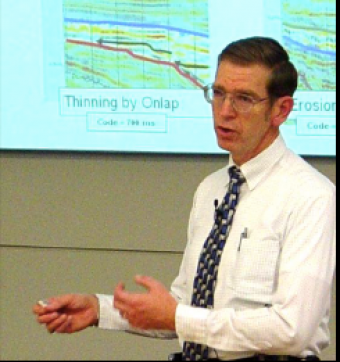This lesson could be divided into three (3) segments. The first could be a review of the exercise associated with 'Reservoir Rocks', followed by the lecture and an introduction to the exercise that reinforces the lecture material. The review of the exercise on 'Reservoir Rocks' will take about fifteen (15) minutes, and has twenty (20) slides. The lecture material presented here contains forty-one (41) slides, and will take approximately fifty-five (55) minutes to present. Lastly, the introduction to this exercise has about fifteen (15) slides, and will take ten (10) minutes to explain. In addition, the exercise itself has one (1) 8-page Word document, and two (2) Powerpoint files for the students to work through. If you choose to print this material, note that the Powerpoints are named to whether they need to be printed in black and white (B&W) or color (COLOR).
The exercise contains five (5) parts that walk the students through an interpretation of Fault V (Parts 1 – 4) and Fault W (Part 5). Students should learn to transfer a fault interpretation from a seismic line to an intersecting uninterpreted line by folding one of the lines at the point of intersection and transferring the pick (fault surface). The instructor should demonstrate the seismic line folding and interpretation transfer (from an interpreted to uninterpreted line) during the introduction to the exercise.
With the exercise, the student should be able to systematically interpret a fault surface on inlines, crosslines and time slices, and come up with an areally consistent interpretation. A correct interpretation will be areally consistent; however, an areally consistent fault is not by definition correct, but it should honor all the available data.
At the end of the lesson, students should be able to:

This course, based on teaching material from Dr. Fred Schroeder (formerly of Exxon/ExxonMobil), reflects on the geology and geophysics basics for the petroleum industry. General geology and basic geophysics are not required, but helpful with the material.
We encourage the reuse and dissemination of the material on this site as long as attribution is retained. To this end the material on this site, unless otherwise noted, is offered under Creative Commons Attribution (CC BY 4.0) license